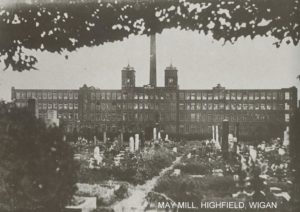
Although now often relegated to shopping outlets – like Ena Mill in Atherton – dusty museum displays, or urban living for aspiring young professionals, mills have always been integral to our local heritage. From the water-driven mills of the eighteenth century to the surge in mechanisation and the eventual decline of the industry, these great structures continue to have a place in the hearts of locals.
The closure of Chorley’s Botany Bay (previously Canal Mill) in February pending its extensive redevelopment into a modern outlet village is a blow indeed to Lancashire’s milling heritage. Mills undeniably shaped the county’s industrial and economic landscape in the 1900s, when the Industrial Revolution settled its focus on textile manufacturing. Somewhere along the line, Lancashire became synonymous with cotton milling, from the invention of James Hargreaves’ spinning jenny in Oswaldtwistle back in 1770 to towns like Burnley making their names in cotton. In fact, the industry expanded enough that the government was forced to introduce a policy to slow its growth down in 1959.
The county suffered many ups and downs during its run as a textile giant. The Lancashire Cotton Famine of 1861-65 was caused by overproduction while international markets continued to shift. The demand for raw cotton slumped just as ports were overwhelmed with an influx of it, causing the price to collapse. Many workers became unemployed, forced to attend soup kitchens and appeal for meal and coal tickets.
The detrimental effect milling had on its workforce is well-documented. Channel 4’s TV adaptation The Mill shed light on the conditions working-class people faced post-Industrial Revolution at Quarry Bank Mill in Cheshire. It’s easy to look back on the industry now with rose-tinted lenses, but with mechanisation came abhorrent working conditions, child labour and many accidents. Many workers reported ‘mill fever’ in their first few weeks of employment; the dust, chemicals and claustrophobic environment landing a hard knock to the immune system. A lot of mill girls communicated solely by lip reading due to the supremely high levels of noise from nearby machinery.
‘…a right pea souper’
That’s without mentioning that textile milling also contributed to the frequent smog during the latter part of the twentieth century, with air pollution from Wigan’s factories turning the streets into a ‘right pea souper’. The 1950s were especially notorious for this phenomenon – although chiefly arising from the frequent burning of coal, bleaching, sizing and bast-fibre processing in cotton mills played their part too. Several WiganWorld members remark on smog masks which left blackened gauze from breathing in the pollution – ‘a small steel frame with a pad attached’ to keep the worst of the smog out of your lungs.
It’s easy to forget the architectural prowess and innovation that went into the building of mills around Lancashire and what is now Greater Manchester, and to dismiss milling as a brutal stopgap into modernisation. Faster processes revolutionised the industry and Britain for the better, and brought industry to Lancashire instead of relying on foreign imports. Despite the integral part milling played in local heritage, many of Wigan’s mills have fallen into disrepair – the derelict Rylands Mill was named one of the top ten most ‘at risk’ buildings in the UK by the Victorian Society in 2016. But many of these imposing buildings have a lot more to offer – and it’s high time they got the appreciation they deserve.
Trencherfield Mill
Built in 1907, the Grade-II listed Trencherfield Mill is currently in its third incarnation. The first Trencherfield mill originated in 1820, but was rebuilt in 1851 and again in the early twentieth century. The mill, owned by William Woods & Sons Ltd., employed around 1000 people. The mill was built to best utilise the Leeds & Liverpool Canal, which was useful in transporting freight like cotton.
William Woods was the first to introduce power looms to Wigan’s cotton mills in 1818. Woods and his family participated in the official christening of the new mill engine in 1908, naming each side of the hulking beast after his daughters Helen and Rina. The steam engine had a horsepower of 2,500 and is still in working order today.
In 1929, Trencherfield Mill was purchased by the Lancashire Cotton Corporation in a last-ditch attempt to save the textile milling industry. World War I saw a halt in production which never fully recovered, leading to the eventual closure of the majority of Britain’s cotton mills. Most survived into the 1960s, but the demand for British cotton was gone and replaced with overseas exports. The mill finally ceased operation in 1968, leaving the huge engine – with its 27 foot flywheel – to fall into disrepair.
And so it remained for a further fifteen years, until a National Lottery Heritage Fund grant led to major restoration works that turned the mill into what it is today – a monument to Wigan’s industrial history.
Trencherfield Mill is currently closed to the public but is set to reopen later in the year. Regular open days allow you to get up close and personal with the mill’s steam engine, and volunteering opportunities are available for anyone interested in preserving Wigan’s milling heritage – visit www.wigan.gov.uk/Resident/Museums-archives/Trencherfield-Mill-Engine.aspx for details.
May & Enfield Mills
Home to two mills which are often confused for one another, the Pemberton area has a fiery textile history. In Highfield, near St. Matthew’s, Church sat May Mill – originally Wilde’s Mill, constructed in 1850. The mill was destroyed by fire in June 1859 and replaced by Roper’s Mill, which also burned down in the late nineteenth century. The site’s turbulent start in life resulted in the final May Mill: a fireproof building built in 1889. Its engines, dubbed Louisa and Helen, were dedicated in 1890.
May Mill was the longest surviving cotton mill in Wigan, still producing cotton until Friday, October 17, 1980.
In the same area, Enfield Mill (situated behind the Enfield pub), was built in 1907 and opened a year later. The mill employed around 200 people, with 500 looms in operation by 1950. During the Second World War, the mill helped construct cloth for barrage balloons, amongst other things. Enfield Mill lasted until December 1975, when it finally closed its doors for good.
Leigh Spinners
The Grade-II* listed Leigh Spinners Mill was first constructed in 1913, and began as a humble cotton mill. The mill knew it would have to adapt to survive after the post-war textile slump, however, and started manufacturing carpets and synthetic turf. In 1923 a larger mill was built on the same site to celebrate – and prolong – its milling successes.
Leigh Spinners is estimated to be the only double-fronted mill still standing in the entirety of Europe still intact. The first mill’s engine was destroyed in an explosion, but the second still stands with its two cylinders christened Mayor and Mayoress. The engine could theoretically be brought back to life, and exists today as one of only four of its kind.
In the early twentieth century, Leigh was home to ten mills, and approximately 15% of the town’s population was employed in the textile industry. Leigh Spinners employed around 800 people in its heyday, boasting staff playing fields, showers and a large canteen to bring its employees together in-between shifts.
Many factors contributed to the decline of Lancashire’s textile industry; the outbreak of WWII meant workers were redrafted into the war effort and away from their jobs, while the rise of foreign imports meant demand for English cotton fell. The Cotton Industry Act of 1959 looked set to rejuvenate Wigan and Leigh’s textile links, with the view of reorganising the cotton industry in Lancashire. The Act reduced the number of spindles in operation while making some workers redundant in order to reduce unneeded output.
Leigh Spinners was mindful of the shifting industry, made evident by its willingness to expand into carpets and gradually reduce its number of employees. It ceased cotton spinning for good in 2005, but continues to produce synthetic turf for sports fields and landscaping.
Although the building has largely fallen into disrepair, the Leigh Building Preservation Trust is doing its best to restore the mill to its former glory. It has won various cash grants to go towards this effort, including a £75,000 prize awarded by Waste Recycling Environmental Ltd. to repair the steam engine and repair the engine house.
The Preservation Trust currently aims to turn the mill into a community hub with a conference centre, indoor sports and various meeting places for local people. In 2018 the Trust signed a 99 year lease on Mill Two, and hopes to secure further funding to keep each floor of the mill preserved.
The mill’s heritage centre opens every Saturday between 10am and 12pm, allowing visitors to get up close and personal with the steam engine and textile machinery. Regular paranormal events also take place at Leigh Spinners if you believe the rumours that the old building might be hosting a bit more than defunct engines!


